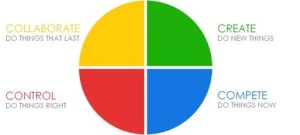Dec 8, 2014
How To Turn Conflict Into Creativity

Two talented people who have nothing in common are more likely to create something exciting than two talented people who think the same way. Harmony is overrated. Innovation is about bringing together individuals with diverse strengths who can push against each other and build something collaboratively that they never would’ve come up with on their own. Innovation happens when there is constructive conflict, or positive tension, within an organization–not total agreement.
The COMPETE, or blue, kind of value represents a Darwinist approach that focuses on competition where the strong prevail at the expense of the weak. This approach represents the drive toward goals and the endgame of power, money, fame, and other tangible forms of success.
The COLLABORATE, or yellow, kind of value is the opposite of COMPETE. Where the COMPETE approach celebrates an aggressive, often cutthroat spirit, the COLLABORATE approach strives for connection, harmony, and togetherness. This approach represents human relationships, the identification with family and clan, and the greater good of Man.

The CREATE, or green, kind of value pursues radical innovation through wild experimentation and extreme dislocation of conventions. This means maintaining a visionary focus on the future, with great adaptability in new environments.
The CONTROL, or red, kind of value is the opposite of CREATE. Where the CREATE approach takes risks and thrives in uncertainty, the CONTROL approach works to eliminate risk. This is about being consistent, using reliable systems and procedures that promote stability.
Every approach has its downside. Red projects face the danger of becoming too bureaucratic. Green projects run the risk of creating too much chaos. Blue projects are sometimes shortsighted. Yellow projects may be overtaken by irrational enthusiasm. This is why you need to combine these approaches to make up for their respective weaknesses. For example, bringing together the stability of a red approach and the experimentation of a green approach encourages creativity while also keeping it within the bounds of procedure.
What happens when pragmatic thinkers work with big-picture thinkers? What happens when the goal-oriented thinkers meet the patient thinkers? This is the kind of variation that sparks innovation. Take a chance and surround yourself with people who don’t think the same way you do as you feel your way to the future. They just might surprise you.
Speaker
Tags
 Jeff DeGraff
Jeff DeGraff